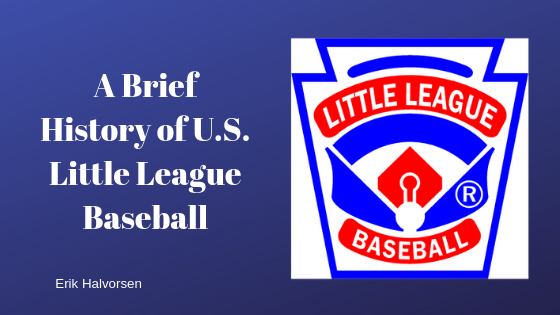Don Henley’s “The Boys of Summer” wasn’t actually about baseball—it was a reflection on getting old and looking back at your past. I was reminded recently of one of my fondest memories as a child—playing baseball. My son, Hunter, just finished his season with his team coming in third place out of twelve teams. It was great to see how much he improved as the year went on—a testament to the time his coaches spent with him and the camaraderie and support of his teammates. As someone who played Little League baseball until high school, I appreciate the core principles of teamwork, sportsmanship and hard work that are reinforced in these kids. My father was always coaching either my team or my brothers and he served as our town’s Little League Commissioner for close to 10 years. It got me thinking about the history of an organization that is as American as it gets!
The origin of the United States Little League Association started with an uncle playing ball with his nephews. Baseball has been in our country dating back to the Revolutionary War with Continental Army soldiers playing “ball” at Valley Forge. Back then, baseball was a modified form of British games Cricket and Rounders. It was shaped into the baseball we know today in the 19th century by Alexander Joy Cartwright. Known as the “father of modern baseball,” Cartwright formed a baseball team called the New York Knickerbockers in 1840, named after Manhattan’s volunteer fire company. Baseball began to become popular when the team was moved across the Hudson River to Hoboken’s Elysian Field in 1845. From there, other baseball teams were formed in different parts of the country, starting with Cincinnati Red Stockings in 1869.
However, little league baseball was slow to take off. An attempt at creating little leagues were formed in the early 1800s in New York, but without success. This left children playing baseball (or stick ball) in the streets. It wasn’t until 1938 when Carl Stotz succeeded in starting a little league for pre-teen boys. He wanted to create a baseball team to teach the neighborhood boys the values of sportsmanship and teamwork. When he came up with the equipment, rules and playing field, he formed neighborhood teams (a league). He funded the league through sponsorships. A $30 donation from a business (sponsor) purchased enough uniforms and equipment for the first three teams: Lycoming Dairy, Lundy Lumber and Jumbo Pretzel. In 1940, a new playing field was created for the league and a second league was formed. The name little league came from “Operation Little League,” when the field was taken over by the war effort. In 1942, Stotz created the keystone logo for the league.
Little League baseball was starting to catch on with 12 leagues (PA) in 1946. In the next decade, there were over 300 leagues across the nation. The first baseball tournament began in 1947, which drew a crowd of 2,500.This was the start of the Little League World Series. Today, there are nearly 3 million players in three divisions: junior, senior and big-league. Girls were welcomed to play little league baseball in 1974. We owe a great deal of thanks to Carl Stotz who took it upon himself to create not just a youth sports program, but also a legacy of sportsmanship for boys and girls.
Erik Halvorsen is a devoted father, loving husband, and ambitious innovator; he is consistently searching for new technology to help cure diseases, benefit patients’ lives, and change how we experience healthcare. He was named one of the top 30 Chief Innovation Officers in healthcare in the country, and he has been listed as one of the Top 40 Under 40 in Boston. Erik is also a member of the Forbes Technology Council.

